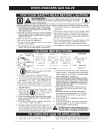
23
FOR YOUR INFORMATION
START UP CONDITIONS
DRAFT HOOD OPERATION
Check draft hood operation by performing a worst case
depressurization of the building. With all doors and windows closed,
and with all air handling equipment and exhaust fans operating
such as furnaces, clothes dryers, range hoods and bathroom fans,
a match ame should still be drawn into the draft hood of the water
heater with its burner ring. If the ame is not drawn toward the
draft hood, shut off water heater and make necessary air supply
changes to correct.
CONDENSATE
Whenever the water heater is lled with cold water, some condensate
will form while the burner is on. A water heater may appear to
be leaking when in fact the water is condensation. This usually
happens when:
a.
A new water heater is lled with cold water for the rst time.
b. Burning gas produces water vapor in water heaters, particularly
high efciency models where ue temperatures are lower.
c.
Large amounts of hot water are used in a short time and the rell
water in the tank is very cold.
Moisture from the products of combustion condense on the cooler
tank surfaces and form drops of water which may fall onto the burner
or other hot surfaces to produce a “sizzling” or “frying” noise.
Excessive condensation can cause pilot outage due to water
running down the ue tube onto the main burner and putting out
the pilot.
Because of the suddenness and amount of water, condensation
water may be diagnosed as a “tank leak”. After the water in
the tank warms up (about 1-2 hours), the condition should
disappear.
Do not assume the water heater is leaking until there has been
enough time for the water in the tank to warm up.
An undersized water heater will cause more condensation. The
water heater must be sized properly to meet the family’s demands
for hot water including dishwashers, washing machines and
shower heads.
Excessive condensation may be noticed during the winter and
early spring months when incoming water temperatures are at their
lowest.
Good venting is essential for a gas red water heater to operate
properly as well as to carry away products of combustion and water
vapor.
S
MOKE / ODOR
It is not uncommon to experience a small amount of smoke and odor
during the initial start-up. This is due to burning off of oil from metal
parts, and will disappear in a short while.
THERMAL EXPANSION
Water supply systems may, because of such events as high line
pressure, frequent cut-offs, the effects of water hammer among others,
have installed devices such as pressure reducing valves, check
valves, back ow preventers, etc. to control these types of problems.
When these devices are not equipped with an internal by-pass, and
no other measures are taken, the devices cause the water system to
be closed. As water is heated, it expands (thermal expansion) and
closed systems do not allow for the expansion of heated water.
The water within the water heater tank expands as it is heated and
increases the pressure of the water system. If the relieving point of the
water heater’s temperature-pressure relief valve is reached, the valve
will relieve the excess pressure. Th
e temperature-pressure relief
valve is not intended for the constant relief of thermal expansion.
This is an unacceptable condition and must be corrected.
It is recommended that any devices installed which could create a
closed system have a by-pass and/or the system have an expansion
tank or device to relieve the pressure built by thermal expansion in
the water system. Expansion tanks are available for ordering through
a local plumbing contractor. Contact the local water heater supplier
or service agency for assistance in controlling these situations.
STRAN
GE SOUNDS
Possible noises due to expansion and contraction of some metal
parts during periods of heat-up and cool-down do not necessarily
represent harmful or dangerous conditions.
Condensation causes sizzling and popping within the burner area
during heating and cooling periods and should be considered normal.
See “Condensation” in this section.
OPERATIONAL CONDITIONS
SMELLY WATER
In each water heater there is installed at least one anode rod (see
parts sections) for corrosion protection of the tank. Certain water
conditions will cause a reaction between this rod and the water.
The most common complaint associated with the anode rod is one
of a “rotten egg smell” in the hot water. This odor is derived from
hydrogen sulde gas dissolved in the water. The smell is the result
of four factors which must all be present for the odor to develop:
a.
A concentration of sulfate in the supply water.
b. Little or no dissolved oxygen in the water.
c. A sulfate reducing bacteria which has accumulated within the
water heater (this harmless bacteria is nontoxic to humans).
d.
An excess of active hydrogen in the tank. This is caused by the
corrosion protective action of the anode.
Smelly water may be eliminated or reduced in some water heater
models by replacing the anode(s) with one of less active material, and
then chlorinating the water heater tank and all hot water lines. Contact


















